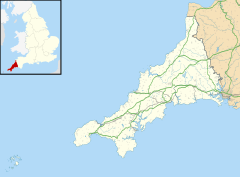Headland Hotel (original) (raw)
| Headland Hotel | |
|---|---|
 |
|
  Location in Cornwall Location in Cornwall |
|
| Alternative names | The Headland |
| General information | |
| Status | Grade II listed |
| Architectural style | Victorian |
| Location | Newquay, Cornwall, England |
| Address | Fistral Beach, Headland Road, Newquay TR7 1EW |
| Town or city | Newquay |
| Coordinates | 50°25′14″N 5°5′49″W / 50.42056°N 5.09694°W / 50.42056; -5.09694 |
| Construction started | August 1897 |
| Completed | 1900 |
| Opened | June 1900 |
| Height | |
| Roof | Mansard Style Roof |
| Technical details | |
| Floor count | 4 |
| Design and construction | |
| Architect(s) | Silvanus Trevail |
| Main contractor | Arthur Carkeek of Redruth |
| Other information | |
| Number of rooms | 95 |
| Number of restaurants | 3 |
| Website | |
| Headland Hotel | |
| Listed Building – Grade II | |
| Official name | The Headland Hotel |
| Designated | 12 May 1988 |
| Reference no. | 1327390 |
The Headland Hotel is a Grade II listed building[1] located in Newquay, Cornwall, England, United Kingdom. It was opened in June 1900 and is built on a prominent position overlooking Fistral Beach and Towan Head.
Silvanus Trevail's Great Western Hotel at Newquay, completed in 1879, was the first in a string of hotels designed to appeal to renewed interest in Cornwall as a winter resort for the middle classes. Trevail's Cornish Hotels Company was formed in 1890.[2]
The company's Atlantic Hotel was built in 1892[3][4] following which Trevail intended to build an upmarket estate, with another luxury hotel, on the headlands of Newquay but lack of money hampered his plans. This scheme provoked a lot of opposition from the local people of Newquay.[5] When building finally began on the Headland Hotel in 1897, riots broke out in the town as it threatened the local custom of using the clifftop as grazing land and space to dry fishermen's nets.[6] This, together with planning problems,[_clarification needed_] delayed completion until June 1900, by which time a rival hotel, the Victoria, which had started construction later, was already open. The contractor for the Headland was Arthur Carkeek of Redruth with the terracotta coming from Ruabon, North Wales. James Shoolbred & Co of London supplied most of the furniture.[7]
Trevail suggested the hotel would be 'The largest hotel in the west', twice the size of the Atlantic hotel and in a better position. The building was lavishly decorated with red Rueben terracotta columns and pediments. It had an electric lift and electric lighting in all 120 rooms.[7][8] Originally the cost of building the hotel was estimated at £25,000 including £4,000's worth of terracotta, but Trevail installed luxurious furnishings from Heal's of London, expensive kitchen equipment, a tennis court and 4 croquet lawns. The eventual cost was £50,000 all together.[7]
The hotel received its first guests in June 1900.[9][4] It is, according to Nikolaus Pevsner, "decidedly disappointing, Victorian, yellow and red brick, tall and symmetrical, pavilion roofs and no redeeming features".[10] It is one of the few hotels in Newquay to retain its original appearance.[1]
In 1911, Edward, Prince of Wales, and his brother Prince Albert (later Kings Edward VIII and George VI respectively) recuperated at the hotel after catching measles and mumps while studying at Royal Naval College, Dartmouth.[11]
During World War II the hotel was requisitioned as an RAF hospital, as were many other hotels in Newquay.[12]
The 1990 film adaptation of Roald Dahl's novel The Witches was shot here, and was called "Hotel Excelsior" in the film.[13]
During the UK lockdown, the ocean-facing side of the building was covered in scaffolding as builders replaced many of the wooden windowsills, restored the four sunset view balconies, and carried out essential repairs to the rest of the exterior, as part of a £55,000 conservation programme.[14]

The Headland Hotel.
Entrance
Towan Head and the Headland Hotel from Fistral Beach
View towards the Headland Hotel from Porth Beach
Cafe at Fistral Beach and Headland Hotel/
- ^ a b Historic England. "The Headland Hotel (1327390)". National Heritage List for England. Retrieved 12 December 2019.
- ^ bwdeacon (7 July 2020). "Tourism: cure or curse?". Cornish studies resources. Retrieved 25 September 2020.
- ^ "Cheers to 125 Years! – Atlantic Hotel Newquay". atlantichotelnewquay.co.uk. Retrieved 25 September 2020.
- ^ a b "Newquay Characteristic Study – Cornwall Council" (PDF). 2003.
- ^ BBC. "Silvanus Trevail". www.bbc.co.uk. Retrieved 25 September 2020.
- ^ BBC. "Silvanus Trevail". www.bbc.co.uk. Retrieved 25 September 2020.
- ^ a b c Silvanus Trevail, Cornish Architect and Entrepreneur. UK: Francis Boutle. 2008. p. 208. ISBN 978-1903427439.
- ^ "File:1950RAC-Head.jpg – Graces Guide". www.gracesguide.co.uk. Retrieved 12 March 2021.
- ^ "About us". Headlands Hotel. Retrieved 23 September 2020.
- ^ Pevsner, N. (1970) Cornwall; 2nd ed. revised by Enid Radcliffe. Harmondsworth: Penguin; p. 126
- ^ Judd, Denis (1982). King George VI. London: Michael Joseph. p. 24. ISBN 0-7181-2184-8.
- ^ "Our History | The Headland 5-Star Hotel in Newquay". www.headlandhotel.co.uk. Retrieved 31 December 2021.
- ^ "The location of the Headland Hotel". The Headland Hotel. Archived from the original on 23 February 2010. Retrieved 5 April 2010.
- ^ "Headland Hotel in Newquay covered in scaffolding as part of £55,000 refurb". InYourArea.co.uk. 29 March 2021. Retrieved 1 April 2021.
